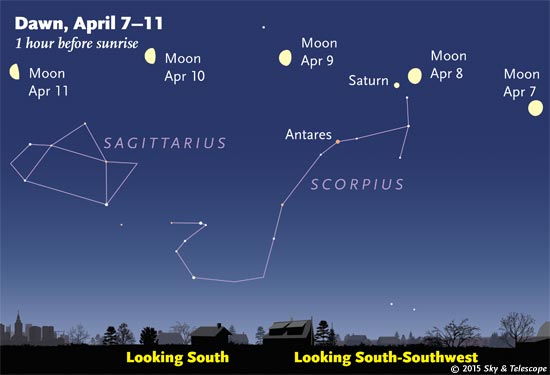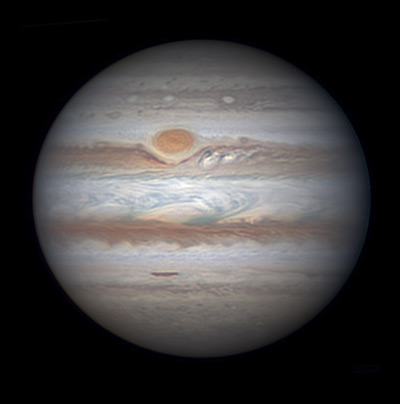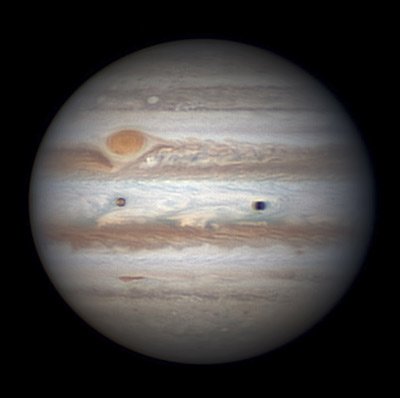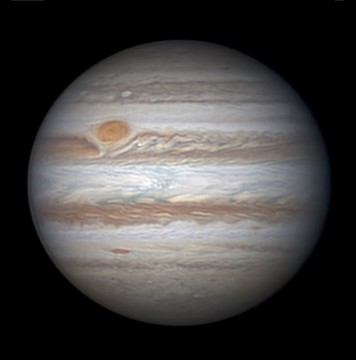Some daily sky sights among the ever-changing Moon, planets, and stars.
Nova Sagittarii rebrightens, refades. The nova that peaked at about magnitude 4.3 on March 21–22, then dropped to 5.9, slowly rebrightened to about 4.5 as of April 5th and then dropped again. See article (with comparison-star chart) and up-to-date light curve. The nova is easy to observe with binoculars. Sagittarius is in the south-southeast just before the beginning of dawn. (Dawn begins about an hour and a half before your local sunrise time).

Friday, April 3
This evening the full Moon shines in Virgo with Spica well to its lower left, as shown here. Much closer to the Moon is fainter Gamma Virginis (Porrima), a close telescopic double star.
A barely total eclipse of the Moon happens before or during dawn Saturday morning for the western half of North America. The farther west you are the better. It happens during Saturday evening for Australia and the Far East. This eclipse is barely total for only about 5 to 12 minutes, depending on how you define the exact edge of Earth's blurry-edged shadow.
Mid-eclipse is at 12:00 April 4th UT (GMT). The partial phases of the eclipse begin at 10:15 UT and end at 13:45 UT. For maps, timetable, and more, see the April Sky & Telescope, page 50, or the version online: Saturday's Total Lunar Eclipse.
Can't see the eclipse from where you are? Griffith Observatory in Los Angeles will run a live webcast from 5:00 a.m. to 9:30 a.m. Eastern Daylight Time (9:00 to 13:30 April 4th UT). The Virtual Telescope Project will also webcast the eclipse, starting at 6:00 a.m. EDT (10:00 UT). So will Slooh, starting at 6:00 a.m. EDT (10:00 UT).
Saturday, April 4
The Moon is still essentially full this evening, much closer now to Spica as shown above.
Sunday, April 5
Are you keeping watch on Venus and the Pleiades? They're drawing closer together day by day in the western twilight. This evening the Pleiades are about 7° above Venus in the darkening blue. The little cluster will pass less than half that distance to Venus's right on April 10th through 12th.
Monday, April 6
After dark, the Big Dipper high in the northeast is tipping over now as if to dump water into the dim Little Dipper's bowl, which is swinging up far below it.
Tuesday, April 7
As dawn brightens on Wednesday morning the 8th, look south for Saturn glowing near the waning gibbous Moon, as shown below.

Wednesday, April 8
April always finds Orion leaning over at dusk low in the southwest, with his three-star belt almost horizontal (depending on your latitude). The belt points left toward bright Sirius, and to the right toward Aldebaran and, farther on, Venus and the Pleiades.
Thursday, April 9
Sirius still shines brightly in the southwest right at nightfall, though it's no match for Venus in the west. Sirius is the Dog Star, the brightest of Canis Major, and now the constellation stick figure of the dog has turned nearly horizontal, as if he's walking westward. His triangular head is much fainter than the rest.

Friday, April 10
Look for the Pleiades just 3° to the upper right of Venus during and after late twilight. That's about two finger-widths at arm's length. Upper left of Venus by 13° is 1st-magnitude Aldebaran, an orange-yellow firespark.
Saturday, April 11
The Pleiades are at their closest to Venus this evening, about 2½° to its right as twilight fades in the west, as shown here.
Want to become a better astronomer? Learn your way around the constellations. They're the key to locating everything fainter and deeper to hunt with binoculars or a telescope.
This is an outdoor nature hobby; for an easy-to-use constellation guide covering the whole evening sky, use the big monthly map in the center of each issue of Sky & Telescope, the essential guide to astronomy. Or download our free Getting Started in Astronomy booklet (which only has bimonthly maps).
Once you get a telescope, to put it to good use you'll need a detailed, large-scale sky atlas (set of charts). The standards are the little Pocket Sky Atlas, which shows stars to magnitude 7.6; the larger and deeper Sky Atlas 2000.0 (stars to magnitude 8.5); and once you know your way around, the even larger Uranometria 2000.0 (stars to magnitude 9.75). And read how to use sky charts with a telescope.
You'll also want a good deep-sky guidebook, such as Sue French's Deep-Sky Wonders collection (which includes its own charts), Sky Atlas 2000.0 Companion by Strong and Sinnott, the bigger Night Sky Observer's Guide by Kepple and Sanner, or the beloved if dated Burnham's Celestial Handbook.
Can a computerized telescope replace charts? Not for beginners, I don't think, and not on mounts and tripods that are less than top-quality mechanically (able to point with better than 0.2° repeatability, which means fairly heavy and expensive). As Terence Dickinson and Alan Dyer say in their Backyard Astronomer's Guide, "A full appreciation of the universe cannot come without developing the skills to find things in the sky and understanding how the sky works. This knowledge comes only by spending time under the stars with star maps in hand."
This Week's Planet Roundup



Mercury is hidden in the glare of the Sun.
Venus (magnitude –4.0) blazes in the west during and after twilight — the "Evening Star." Not until a good hour and a half after complete darkness does Venus set in the west-northwest. Look for the Pleiades above it, closer every day. The little cluster passes to Venus's right on the 10th and 11th.
Mars (magnitude +1.4, less than 1% as bright as Venus) is gradually sinking farther down and away to Venus's lower right in twilight. It's 18° from Venus on April 3rd and 22° from it by the 10th. Mars has been hanging on in the western twilight ever since last summer, but now it's finally on the way out.
Jupiter (magnitude –2.3, in Cancer) shines high in the south at dusk. It's the brightest point of light high on that side of the sky. In a telescope Jupiter is still 41 arcseconds wide. Don't expect to see nearly the detail with your eye that video-frame stacking with a large amateur telescope can bring out, such as in the fine images here!
Saturn (magnitude +0.3, at the head of Scorpius) rises around 11 or midnight daylight-saving time and is highest in the south in early-morning hours. Below or lower left of Saturn, by 9°, is orange Antares, not quite as bright.
Uranus and Neptune are out of sight behind the glare of the Sun.
__________________________
All descriptions that relate to your horizon — including the words up, down, right, and left — are written for the world's mid-northern latitudes. Descriptions that also depend on longitude (mainly Moon positions) are for North America.
Eastern Daylight Time (EDT) is Universal Time (UT, UTC, or GMT) minus 4 hours.
__________________________
“This adventure is made possible by generations of searchers strictly adhering to a simple set of rules. Test ideas by experiments and observations. Build on those ideas that pass the test. Reject the ones that fail. Follow the evidence wherever it leads, and question everything. Accept these terms, and the cosmos is yours.”
— Neil deGrasse Tyson, 2014.
 1
1
Comments
Ray-Mckenna
April 4, 2015 at 6:59 pm
What beautiful views of our Jovian neighbor.
I never tire of it.
You must be logged in to post a comment.
You must be logged in to post a comment.